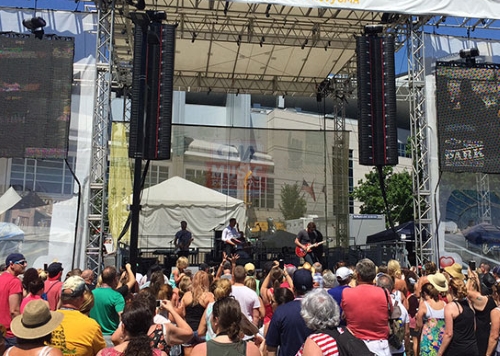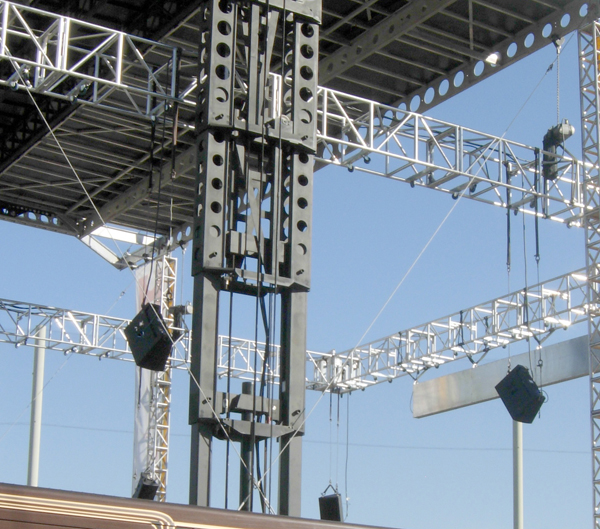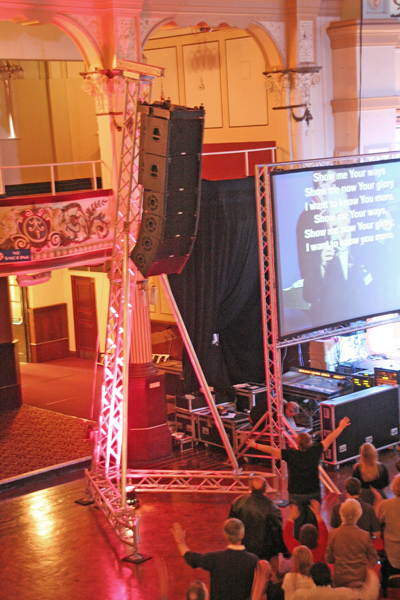
Pole-Mounted From A Subwoofer
On shows where a little more bottom end is needed, it’s very common to see full range loudspeakers mounted over subwoofers on poles. These poles can be fixed in length or adjustable. Some slip into a pole socket on the sub, others screw into the sub.
Make sure to use the manufacturer’s recommended pole because others may not be compatible or as stable. Check the collars and any height adjustment pins before use. As with any stand, make sure the subwoofer is on stable ground and level.
Ground Stacked
If the subwoofers are tall enough, full range loudspeakers can simply be placed on top of them. While a stack of loudspeakers can look solid and secure, they can fall due to vibrations.
Truck straps can be employed to keep the stack together, but strapped stacks can be top heavy, and again, vibrations from the subs or a crowd pushing to get closer to the stage can cause them to topple. Using a larger subwoofer that provides a bigger footprint as the base of a stack can add stability.
Scaffold Supported
To get a stack of loudspeakers higher in the air, they can be placed on or flown from scaffolding. This was a common practice before line arrays and flown horizontal arrays became the norm, and is still quite common at festivals and fairs where there are no ceiling points (usually in tents and outdoors.)
Make sure the structure is level and all decking and cross bracing is in place before loading the tower. Stacked loudspeakers should be secured to the decking with ratchet straps so they don’t vibrate off. Outdoors, all scaffolding should be guyed down to ground stakes or sufficient ballast in case of winds, and screw jack legs should be used to level the structure.
Line arrays can be flown inside scaffolding towers, with the chain motor for the array usually connected to a beam secured across the top of the tower. Make sure the beam is secured to the tower and not just held in place by the weight of the PA.
Note: Signage and banners placed on the scaffolding act like sails and will transmit high wind loading to the system. Using an open weave fabric for the signage will allow some wind to blow through, reducing loading on the tower. Also, banners should have a quick release system in place so they can be removed rapidly in case of unexpected high winds. A person should not have to climb the tower in high winds to remove the banners.
Line Array Tower Truss
One of the newest options, they’re made of truss sections and specialty hardware fittings. Make sure all of the bolts are put into place and tightened down to the manufacturer’s recommended torque settings, and level the tower before use. When deployed outdoors, the towers must be guyed to the manufacturer’s recommendation. Some tower trusses allow subs to be placed on the outrigger legs, and these can act as additional ballast.
Truss Totems
A single loudspeaker or multiple smaller boxes may be flown from a vertical stick of truss bolted to a base called a truss totem. These are popular on corporate gigs for delay loudspeakers and lighting, but can be top heavy so additional weights like sandbags can/should be placed on the base for added stability.
If mounting a single loudspeaker on top, make sure it’s center of gravity is directly over the truss. When used with a column-type model bolted to one side, additional weight should be placed on the base on the opposite side of the tower to offset any imbalance.
Crank Towers
These come in all sizes, from small units that look like standard tripods to large, heavy-duty structures that can hold 600 to 800 pounds.
Smaller models may just have a spigot on top for a single loudspeaker and larger units may have forks that can be used to attach an array (or a truss). Make sure to level the tower and extend all outrigger legs as per the manufacturer’s instructions.
Crank Towers With Truss
A common way to support both loudspeakers and lighting is to span a truss across a pair of crank towers. Make sure the truss is secured to the tower forks, and never overload the structure. Factor in the weight of any lighting and cables, plus the weight of the truss and any rigging hardware when determining the total weight these are supporting.
Dead Hang
This refers to an item like a loudspeaker that is attached to a building temporarily, but not with a chain motor. A man-lift is needed to get the installer and loudspeaker(s) up in the air and attached to the building component, usually a beam.
Only a competent or qualified person should install dead hang items, and a structural engineer should determine the weight capacity of the point before use.
Chain Motors
They’re used to support truss, video systems, and of course, loudspeakers. Motors can be placed up in the air with their chains hanging down, or more commonly, the dead end of the chain is hung from the rigging point, with the motor climbing the chain, hauling its load to height.
Chain motors are great because the rig can be built on the ground and lifted to height, with height adjustments easy to make if needed. Only competent or qualified people should hang and operate motors, especially when used in multiples.
Before use, check the motor hooks and inspect the chain for any signs of damage. Be sure the chain bag is attached correctly and is in good shape. Before any motor is operated, make sure that everybody on the deck is aware that something will be moving. And before an array or truss is lifted, a competent person should double check all rigging hardware and fittings.
Construction Lifts
They’re sometimes used to elevate or fly loudspeakers at festivals and lift personnel inside buildings to attach items like motors to ceiling points or beams. All people in boom lifts should be wearing the proper fall protection equipment, and fork lifts should never be used to lift people.
Scissor lifts are popular when small horizontal arrays need to be raised, moved or relocated at events like air shows. Larger festivals might utilize construction cranes or large extendable boom forklifts to fly the main PA system. Make sure the equipment operators are certified for that model unit, and that an operator is monitoring the equipment continuously during use.
Weight capacity changes depending on the angle of the boom, so it’s vital to not overload the equipment during use. Tag lines should be used to keep an array from swinging in the wind. An engineer should determine the maximum wind speeds the systems can operate in, and if the wind reaches that limit, the PA should be lowered immediately to the ground.
Obviously, safety is the key. By using the right equipment and following the rules, what goes up will stay up!



